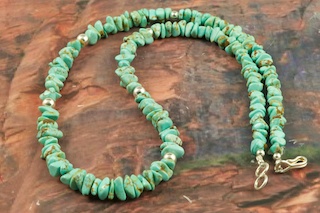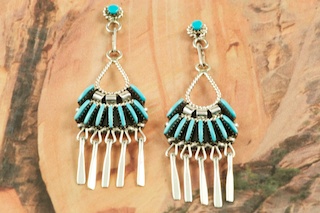Learn About Turquoise
Turquoise
CuAl6((OH)2.PO4)4CuAl6(PO4)4(OH)8+4H2O
Turquoise is a hydrated copper and aluminum phosphate occurring exclusively in desert and arid environments. It is found in veins and nodules in weathered volcanic or sedimentary rocks where it forms as a secondary mineral by the process known as hydrothermal replacement. This process occurs when percolation of meteoric or ground waters leach out chemicals in nearby rocks that are then moved into cracks where they combine with other materials to form new minerals.
Turquoise ranges in color from blue through shades of green to yellowish grey. At temperatures of 500 degrees C, blue turquoise stones will become greener.
History of Turquoise
Turquoise was first mined by Egyptians on the Sinai Peninsula as early as 6000 B. C. and transported to Europe through Turkey, accounting for its name, which means "Turkish" in French. The stones taken from these mines were used for making jewelry, amulets and cosmetics. In 1900, archaeologist who excavated the tomb of the Egyptian Queen Zer (5500 BC) found a Turquoise and gold bracelet on her wrist, making it one of the world's oldest known examples of jewelry.
Turquoise was also one of the most important stones in Pre-Columbian America and has been extensively used since about 200 B.C. by both southwestern Native Americans and by many of the Indian tribes in Mexico. In fact, turquoise was more valuable than gold to the Aztecs of Mexico - a notion that was passed on to the conquering Spaniards.
The finest turquoise traditionally came from Iran and Tibet, but the majority of the world's finest- quality turquoise today comes from the United States, the largest proucer of turquoise. Turquoise also occurs in Northern Africa, Australia, Siberia, China and Europe.
Nevada and Turquoise
Nevada has been a major producer of turquoise since the 1930's, and until the early 1980's, the state was the largest producer in the United States. It is estimated that over the years, 75 tp 100 different mines/prospects produced sizable quantities of turquoise. To date, the total production of rough turquoise is estimated to be in the range of $40 to $50 million.
Turquoise is the official state of Nevada semi-precious gemstone.
The Turquoise used in our Native American Indian Jewelry is mined in the American Southwest. The Native American Jewelry Artists use Turquoise in their jewelry from mines in Arizona, Nevada, Colorado and New Mexico.
Turquoise is a semiprecious stone found in many arid regions of the world and used for over 1,500 years in making turquoise jewelry. In pre-Hispanic times Southwestern Indians mined turquoise with stone hammers and picks made of antler. Fire was used to crack bedrock containing the Turquoise. The largest of these early mines was near Cerillos, New Mexico, near the present day Santa Fe. It extended 200 feet underground and was 300 feet wide in places. Turquoise from pre-Columbian mines in the Southwest was widely traded, some traveling as far as the Aztec Empire in Mexico.
The colors of turquoise range from a deep green to a light blue. Most of the stones will have a matrix marking which will vary from stone to stone. Both color and matrix markings are a matter of personal preference. True collectors appreciate the variety and will own several pieces of turquoise jewelry with different colors and markings.
The Turquoise in the Jewelry comes from various mines the the American Southwest. It is the best quality turquoise you can find. Mother Nature is amazing! These natural turquoise stones have a variety of colors from bright blue to dark greens with beautiful matrix. This is a sampling of a few of the most popular Turquoise Mines.

This is an example of Number 8 Mine Turquoise.
Number 8 Turquoise has character in its appearance and can easily be identified. Few gemstones have such a variety in appearance as to have individual character and personality as the Number 8 Turquoise. With its golden brown to black distinctive spider web matrix and unique bright powder blue and green background. it has been valued for its beauty and reputed spiritual and life giving qualities. The Number 8 Turquoise mine was discovered in 1925 and first mined in 1929. The Number 8 mine is located in Eureka County Nevada. Since 1976 there has been no Number 8 Turquoise mined. There is however, an existing stock pile that Mr. Dowell Ward, the last owner of the Number 8 mine, had stocked away for later sorting. The Turquoise is a collector's item--because once the reserve is gone there will be no more material released onto the market. The Gold Mining Company owns the claim to the Number 8 mine and it has been swallowed up by the gold mining operations. This is some of the last Number 8 Turquoise to be had and will be a great addition to your collection.
This beautiful Turquoise Necklace was created by Navajo Artist Petra Vandever.
.jpg)
Here is an example of Kingman Turquoise. The Mineral Park Mine, in the Cerbat Mountains 14 miles northwest of Kingman, was first mined by Indians centuries before white man came to the area. It is one of the three sites of prehistoric mining localities in the state of Arizona. Mineral Park was the most extensively worked area by the Indians of the three. S.A. "Chuck" Colbaugh found a cache of stone hammers uncovered in ancient trenches and tunnels, when he had the turquoise mining concession in May of 1962. Ithaca Peak and Turquoise Mine (formally called Aztec Mountain or Aztec Peak) are the most famous of the peaks in the area containing turquoise. Created by Navajo Artist Phillip Sanchez.

This is an example of Sleeping Beauty Turquoise. The Sleeping Beauty Turquoise mine is located in Gila County, Arizona. Sleeping Beauty Turquoise is relatively abundant. The turquoise mine produces uniform blue turquoise that is easily matched and used in many styles of Native American Jewelry including Zuni needlepoint and inlay pieces.
These beautiful Turquoise Earrings were created by Zuni Artist Edmund Cooeyate. Zuni Artists are known for their fine petit point work in their Turquoise Jewelry.
Care of your Turquoise Jewelry
Do not use ultrasonic cleaners, steamers, chemicals or heat on your Turquoise Jewelry. Clean your Turquoise Jewelry with warm soapy water and dry with a soft cloth. Then let it air dry. Keeping your Turquoise Jewelry set in Sterling Silver, in an air tight plastic bag will help to avoid tarnish, when you are not wearing it.
By Donna Bunnell
.png)